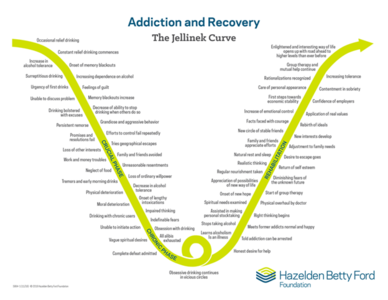
Courtesy of the Hazelton Foundation
The Jellinek Curve, created by E. Morton Jellinek in the 1950s and later revised by British psychiatrist Max Glatt, is a chart that describes the typical phases of alcoholism and recovery. The point of this research was to show that alcohol addiction is a progression and there's a "vicious circle" associated with obsessive drinking, with much to lose along the way if people don't seek help. The curve shows that life can get worse if the cycle of dependence isn't broken, but it can also get better through recovery.
Do you drink to feel better about yourself? Do you drink to dull the pain? Do you drink to forget, stop worrying, or eliminate anxiety? If so, your drinking could escalate without help.
Blacking out from drinking too much is a warning sign of this stage, along with lying about drinking, drinking excessively, and thinking obsessively about drinking.
At this point, it's obvious to those close to you that you're struggling. You might miss work, forget to pick up the kids, become irritable, and notice physical signs of alcohol abuse (facial redness, weight gain or loss, sluggishness, stomach bloating). Support groups can be a highly effective form of help at this stage.
At this stage, drinking becomes everything in your life, even at the expense of your livelihood, your health, and your relationships. Attempts to stop drinking can result in tremors or hallucinations, but therapy, detox, and rehab can help you get your life back.
Once stabilized, the goal is to transition from detox to treatment, to maintenance (practicing sober living by changing your life), to transcendence—the final step in the path to recovery
Recognizing the symptoms of alcoholism can make a tremendous difference in getting proper treatment and heading down the path to recovery. Some warning signs include:
If you think a family member or loved one might be showing signs, signals or symptoms of alcoholism, know that it won't "go away" on its own. Their brain is changing—and without help, there can be serious long-term consequences. According to the National Institute on Alcohol Abuse and Alcoholism, "an estimated 88,000 people die from alcohol-related causes annually, making alcohol the third leading preventable cause of death in the United States." Learn more about alcohol addiction and treatment.
